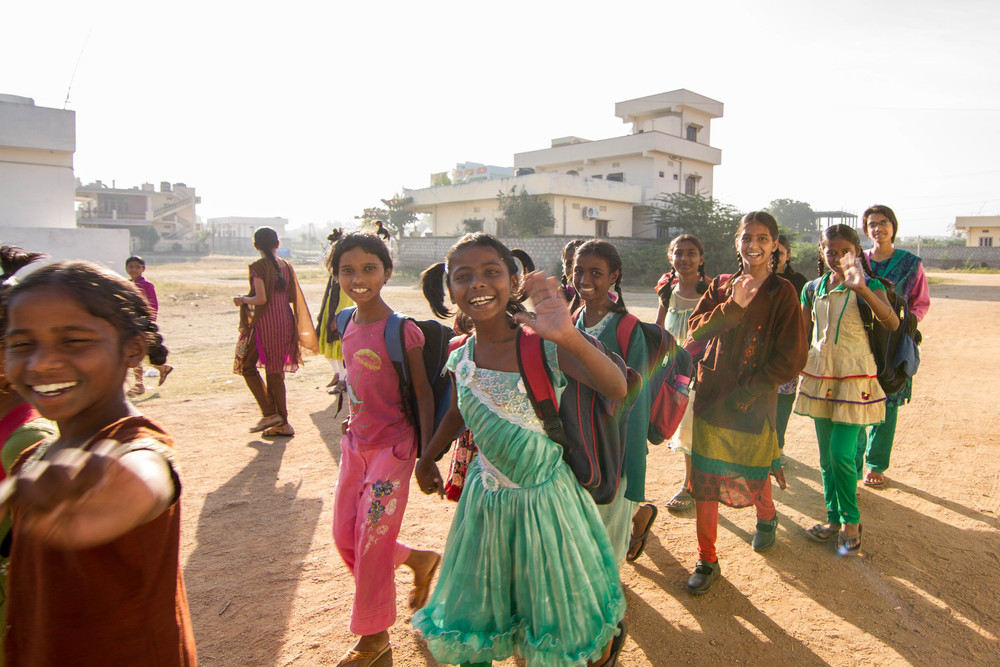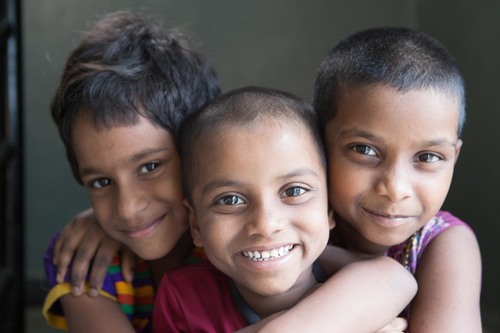FROM THE HEART: SPANDANA CHILDREN’S HOME
Spandana is a reminder of the incredible power that selfless commitment to a social mission has to uplift and transform lives. Located in Hyderabad, India, Spandana is a children’s home currently fostering 59 orphan and semi-orphan children and adolescents. All were brought together as a labor of love and direct service by co-Directors Uttam Kumar and Shobha Rani. This husband and wife founding team each had their formal training in social work, but their exceptional dedication come straight “from the heart,” as Ms. Rani said.
The experiences of community-based organizations like Spandana can provide valuable insight and inspiration to philanthropists and practitioners who aim to address the same issues, plan to work in the same operating environment, or seek local implementing partners. Our interview with Ms. Rani, founder and co-Director of Spandana Children’s Home, not only covered the origins of Spandana as a non-governmental organization (NGO), but also touched on the daunting challenges of operating an NGO in India and how, despite these hurdles, Spandana is succeeding in its mission of providing a loving home to 59 children.
Why did you decide to incorporate Spandana as an NGO?
In 2015, Spandana Development Director Anjali Daryanani produced a 15-minute mini-documentary showcasing the organization’s founders alongside the stories of the children who make Spandana their home.
In 1999, when we incorporated the NGO, we had already been doing this work, picking up children from the streets. We started as volunteers, myself and my husband. Whenever we saw a child on the streets, we used to pick up those children and enroll them in children’s homes where they could get rehabilitation and education or whatever place where their needs could be met.
One day we found an abandoned girl on the roadside—she was a mentally challenged child who could not speak. This child was on the streets for three days, abandoned by her family. She didn’t have anyone to take care of her; she was very dirty and didn’t have toilet training. We picked up the child and took her to one of the homes run for mentally challenged children, but seeing her condition and the fact that this home was over its capacity, the home refused to take her. So instead we brought her to our home and gave her a bath, a haircut, and nice clothes. After that, she started staying with us for the next several months. She began behaving well, picking up words, saying “Mom,”“Dad” along with my kids—how a child normally does with her parents.
“We didn’t want to just provide some things to these children. We wanted to provide them with everything; everything that a parent would give to his or her own child.”
After the first few months, we took the child, who was now in a better condition because of our care, to the same NGO. After we pleaded with them, they made space to accept her and care for her. This incident made us think that if an NGO meant to work for the welfare of shelter-less children cannot accept the child with open arms, then it is the duty of my husband and I to do something for those children. That is how Spandana started in 1999.
After that first child, we started taking in orphans, street children and begging children, as well as children in the most desperate situations. As our numbers grew, from a few orphans to now 59 children, we continue to provide each child with the care, support, counseling and quality education that a mother and father would give to his or her own children. These children are our own children.
What makes Spandana different from other children’s homes in Hyderabad?
Spandana means “to reach out with a spontaneous response” in Telugu, because we started with the motive to receive a child as she or he is. We are here to respond to the needs of the child, whoever it may be—a mentally challenged child, a child with HIV/AIDs, a child without parents, a child without education. We treat each child as an individual, and use different strategies to reach out to the child based on their individual personality and needs of each child.
“When we started this program, we never had a penny in our hands, we never approached anybody for funds, we just volunteered. Our heart is in it.”
We also wanted Spandana to be different from other children’s centers, which were overflowing and providing only the bare minimum food and care for children. We didn’t want to just provide some things to these children. We wanted to provide them with everything; everything that a parent would give to his or her own child. Another difference is that we treat children at Spandana as a family. We are not an orphanage; we are a family. The children here care for one another as brothers and sisters. From our perspective, we never differentiate between those children and ours—we treat them as our own kids. The children care for one another as brothers and sisters
The final big difference is that I’ve seen a lot of organizations and NGOs work for the cause of children but for us, we feel that we have a responsibility toward these children, above all we strongly feel that we have a calling. When we started this program, we never had a penny in our hands, we never approached anybody for funds, we just volunteered. Our heart is in it. It is not just because someone has assigned this responsibility to us, it’s not as if some funding agency came to us and assigned this task. This passion came from our heart, and it is there to stay as long as there are children in need.

Photo CREDIT: ANJALI DARYANANI
What are the challenges of running an NGO here in Hyderabad?
“Many NGOs in this country are actually corrupt… It is hard when people assume you are dishonest because of the reputation of other NGOs.”
First, the biggest challenge is lack of funds—that is the most major thing that affects an NGO. Many people do not trust NGOs in India, because many NGOs in this country are actually corrupt. Spandana is our personal mission, our life’s work, and to accomplish our mission, we need to ask people [for funds]. But it is hard when people lack trust and assume that you are corrupt or dishonest because of the reputation of other corrupt NGOs.
There is also problem with the neighborhoods we have operated in. When we ran this program in colonies renting homes, everyone sympathized with what we were doing for these needy children but they never wanted us to keep these children in their neighbourhoods. We had to move children from one place to the other several times before God heard us and we finally have a place of our own, thanks to the help of World’s Children. Before World’s Children helped us obtain our very own property for the children’s home, we were struggling to pay the rent every month at the previous homes where we have sheltered our children, and we have sold most of our own personal assets to pay our rent and other necessary costs for the children’s home.
How do you measure the success of Spandana?

Photo Credit: Anjali Daryanani
Every child under our care is having a healthy, happy, enriching and beautiful childhood. We are giving the children their right to be a child, and not have to face the dark realities of homelessness, poverty, and abuse that they previously faced. We are able to provide these children with everything that we possibly can—nutritious food, shelter, clothing, education, and health through our initiative.
But every child wants to do something and become someone big in life. In order to realize those goals for them, we need to work hard. One of my measures of success would be that every child should have a sponsor to support their education until they complete their graduation. Another success indicator is all the children reaching their career goals in next five to eight years and we see them as doctors, engineers, anything that they have their goals set on. They are happy and already make us proud with their achievements.
What is your vision for Spandana’s children and for Spandana as an organization?
“There are 59 children we are able to take care of at Spandana, but with community sponsorships and help of the global community, we in a position to reach many hundreds or thousands of children in need.”
I want to see Spandana’s children at a very high place that they couldn’t even imagine before they came to us. They never knew they could attend an international school. Now, as of last year, with the good work and support being raised by [Director of Development] Anjali Daryanani, we were able to place the children in an excellent school—Indu International School—where they are learning so much and experiencing growth in confidence and personal development.
But that’s not all. After finishing their education, we want them to be self sufficient and have a good life, or to become leaders of positive change in this world, which many of them are likely to be. We feel that since these kids have been offered a second chance in life, and know the true power of a helping hand, they themselves will feel it in their heart to also transform the lives of others in need.
In the future, I hope that Spandana can start a program to sponsor the full education of some of Hyderabad’s most needy and deserving children, whose parents are not able to afford to pay their school fees and meet minimum schooling needs. That is also our vision. There are 59 children we are able to take care of at Spandana, but with community sponsorships and help of the global community, we in a position to reach many hundreds or thousands of children in need.
This interview has been condensed for clarity and brevity. To learn more about Spandana, visit www.spandanasociety.in and check out the 15-minute documentary, “Spandana.”
Cover photo: Spandana co-Director Shobha Rani with Children of Spandana. (Photo Credit: Anjali Daryanani)



Got something to say?